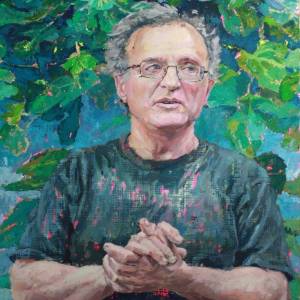Not Paine's Birthday
A year ago I blipped our annual celebration of Charles Dickens' birthday.
This year the event was repeated and all went well. However, I was less enthusiastic than in previous years.
There are three reasons why Dickens is celebrated in my neighborhood rather that in some other place with absolutely no association to the great writer:
1. Dickens was an extremely important, gifted, and prolific novelist.
2. By a series of benign accidents, this bronze statue, "Dickens and Little Nell," found a permanent home in Clark Park, and it brings much pride and delight to everyone here.
3. Charles Dickens' name is not Thomas Paine.
Thomas Paine had everything to do with this city and a little with this neighborhood.
A bust of Paine by sculptor Sidney H. Morse was commissioned by the National Liberal League by subscription in 1876. The bust was offered to the City of Philadelphia and intended for display in Independence Hall (the highest possible honor), but the city's Select Council rejected it. The bust was finally placed on display there in 1905, and remained until 1931, when it was removed due to lobbying by an influential catholic lawyer and placed in a basement storage room. In 1957 it was transferred to the premises of the Friendship Liberal League in the Olney section, and finally in 1967 it came to APS and remains there, in a private office, today. Few living persons have ever laid eyes on this bust. I have seen it twice.
"Paine's Park," designed for skateboarders, is beautiful and has been much-loved since the moment of its opening. There is no object in the park that indicates, in any way, who Paine was. His first name, Thomas, does not appear anywhere in the park. This public religious bigotry has continued for over two centuries and is a glaring miscarriage of historical memory, peculiar especially to Philadelphia.
Since long before Paine even died, influential Christian religious bigots have been smearing him and robbing him of his legacy. City Council once nixed a statue of Paine in our lovely Fairmount Park, because it would "offend passing Christians." President Theodore Roosevelt once called Paine a “filthy little atheist.”
Without Paine's incredibly powerful pamphlets, we would have lost the War of Independence --it's that simple. But while many of the founding fathers were Deist, Paine went so far as to write about it, drawing the eternal hatred of the smallest and lousiest minds on the planet.
There are two impressive monuments to Paine in New Jersey, but none in Philadelphia, where the man made most of his colossal contributions to History. There is only a plaque where he wrote "Common Sense," a plaza downtown named after him (again, only a plaque stating his name), and there's this small piece of parkland along the river, shyly, sneakily referencing the hero. Compare that to Betsy Ross, in whose memory we have a large bridge and a museum. But Ross only might have manufactured the first stars-and-stripes US flag –only one statement of her descendants' tradition says so –and if she did, it changed nothing.
Thomas Paine, the only “founding father” who was not an aristocrat, who never collected even a penny for writing the best-selling tracts of his century, turned the American Revolution from a certain defeat into a victory by his pamphlets. This is not disputed. In fact, President Obama quoted Paine in his first inaugural address, but without naming him --in fact giving the impression that George Washington might have written the words:
"In the year of America's birth, in the coldest of months, a small band of patriots huddled by dying campfires on the shores of an icy river. The capital was abandoned. The enemy was advancing. The snow was stained with blood. At the moment when the outcome of our revolution was most in doubt, the father of our nation ordered these words to be read to the people:
"Let it be told to the future world, that in the depth of winter, when nothing but hope and virtue could survive, that the city and the country, alarmed at one common danger, came forth to meet it."
Finally, I should mention that when the British took over Philadelphia in September of 1777, Thomas Paine passed through this neighborhood, following the Baltimore Pike on his way to York, Pennsylvania. There is a legend that he stopped at the Cherry Tree Inn, which once stood about three blocks west of this statue of Dickens, at Baltimore Ave & Farragut Street.
Happy Birthday, Charles.
Thank You, Tom Paine, for being one of the great heroes of the modern world, right here in our city. I am ashamed that you are not honored here.

Comments
Sign in or get an account to comment.


